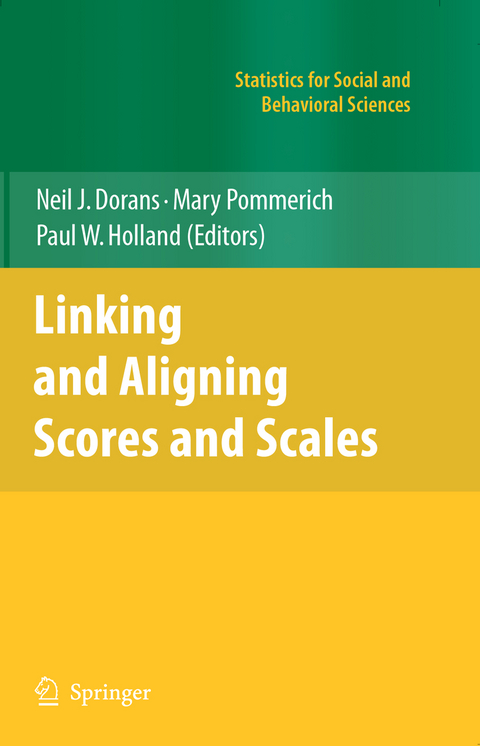
Linking and Aligning Scores and Scales
Springer-Verlag New York Inc.
978-0-387-49770-9 (ISBN)
Overview.- Overview.- Foundations.- A Framework and History for Score Linking.- Data Collection Designs and Linking Procedures.- Equating.- Equating: Best Practices and Challenges to Best Practices.- Practical Problems in Equating Test Scores: A Practitioner’s Perspective.- Potential Solutions to Practical Equating Issues.- Tests in Transition.- Score Linking Issues Related to Test Content Changes.- Linking Scores Derived Under Different Modes of Test Administration.- Tests in Transition: Discussion and Synthesis.- Concordance.- Sizing Up Linkages.- Concordance: The Good, the Bad, and the Ugly.- Some Further Thoughts on Concordance.- Vertical Scaling.- Practical Issues in Vertical Scaling.- Methods and Models for Vertical Scaling.- Vertical Scaling and No Child Left Behind.- Assessments Linking Group Assessments to Individual.- Linking Assessments Based on Aggregate Reporting: Background and Issues.- An Enhanced Method for Mapping State Standards onto the NAEP Scale.- Using Aggregate-Level Linkages for Estimation and Validation: Comments on Thissen and Braun & Qian.- Postscript.
From the reviews:"Linking and Aligning Scores and Scales is about-making scores from revised tests, different tests, and evolving tests as similar as possible. … Overall, this is an impressive and important volume. … It is essential for those who work in the area of educational testing and should be read by those who produce and publish psychological tests. It would be wonderful if members of the media and state superintendents of schools would read it." (Jay C. Thomas, PsycCRITIQUES, Vol. 52 (52), 2007)"This edited volume gathers some of the finest thinking on the complex topic of score linking. The contributing authors are among the best in the field of psychometrics, and the papers are well written and easy to read. … Therefore, it offers a great deal of knowledge, insight, and wisdom to researchers and practitioners … . this is an excellent book and well worth the read for advanced graduate students, researchers, and practitioners with an interest in the field of test score linking and equating." (Lisa A. Keller, Journal of the American Statistical Association, Vol. 103 (484), December, 2008)"The authors discuss different kinds of linking scenarios in a systematic way. Each topic is addressed by practitioners who have had years of experience in dealing with the practical issues presented in the book. … This book would serve as a nice textbook for students interested in psychometrics and is a handy reference book for practitioners. I highly recommend anybody who is interested in linking to read the book and keep it as a reference." (Qing Yi, Psychometrika, Vol. 74 (1), March, 2009)Dorans, N.J., Pommerich, M., & Holland, P.W. (2007). Linking and Aligning Scores and Scales. “ …I recommend the book to anyone who is involved, even remotely, in test development and design. …I had the good fortune of attending most of theconference on which this book is based. There was a palpable sense of excitement in the air, and rightly so since some of the most prominent psychometricians were in attendance, summarizing and exchanging views about what was one of the shining accomplishments of psychometrics in the 20th century, namely the development of equating methodology. At the same time, there was a discussion about the immediate challenges raised by current educational tests of the 21st century. The editors and the authors deserve credit for transferring that sense of excitement to the book, a rare accomplishment for edited technical books. The book is a must-read for practicing and academic psychometricians.” (Journal of Educational Measurement , Summer 2010, Vol. 47, No 2, pp. 255-260)
| Reihe/Serie | Statistics for Social and Behavioral Sciences |
|---|---|
| Zusatzinfo | XX, 396 p. |
| Verlagsort | New York, NY |
| Sprache | englisch |
| Maße | 155 x 235 mm |
| Themenwelt | Geisteswissenschaften ► Psychologie ► Test in der Psychologie |
| Mathematik / Informatik ► Mathematik ► Wahrscheinlichkeit / Kombinatorik | |
| Sozialwissenschaften ► Pädagogik | |
| Sozialwissenschaften ► Soziologie ► Empirische Sozialforschung | |
| ISBN-10 | 0-387-49770-6 / 0387497706 |
| ISBN-13 | 978-0-387-49770-9 / 9780387497709 |
| Zustand | Neuware |
| Haben Sie eine Frage zum Produkt? |
aus dem Bereich


